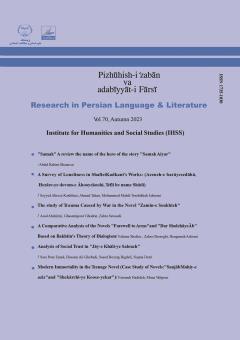identities and Iranian identity has been on the border between
alignment, contradiction, conflict and rupture. Political and social
narratives of the issue of Iranian identity and its elements are effective
in weakening or strengthening this relationship. Among the t
More
identities and Iranian identity has been on the border between
alignment, contradiction, conflict and rupture. Political and social
narratives of the issue of Iranian identity and its elements are effective
in weakening or strengthening this relationship. Among the three
nationalistic, modern, postmodern and historical narratives, it is the
only historical narrative that pays attention to the maximum
consolidation and unity of Iran and Iranians by avoiding excess and
exaggeration in explaining the problem. Ebrahim Yunsi, a political
activist, translator and writer of Iranian Kurdish descent, is the author
of several works in Persian. Some of what he translated is about
Kurdish cultural and political history and contemporary political
events. In the introduction or footnote of most of the translations, he
pays attention to the relationship between Kurds and Iran, and in a
way of Focusing on identity between Kurds and Iran, he establishes an
aligned and consistent relationship. Also, in his works, he criticizes
the opinion of writers who have highlighted some of the elements of
ethnic identity in order to weaken Iranian identity, or who believe in
the distinction and separation between ethnic identity and Iranian
identity. He is especially aware of the role and function of the Kurdish
language and the Persian language. Therefore, in spite of his primary
political affiliation or contrary to what some political parties think, he
believes that there is an equal relationship between the Kurdish
language and the Persian language. Therefore, he uses the Persian
language to write and tries to increase the richness of the Persian
language and its lexical and cultural treasure in his works by using a lot of words and what is Kurdish knowledge and language. In this
article, by analyzing the introductions of the translations and paying
attention to the linguistic issues of the stories, this aspect of the
identity in opinion of Ebrahim Yunsi has been discussed.
Manuscript profile


